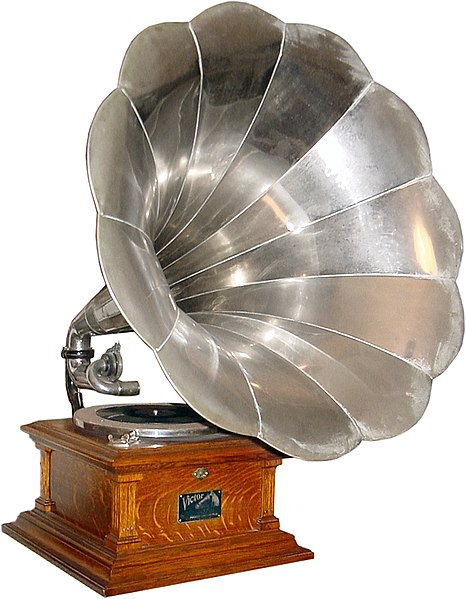
Best invention of the Victorian age? Probably the light bulb. Telephone is up there. But where would our ipods and CD players be today without the great grandmother that started it all, the victrola.
That’s actually not quite right. Thomas Edison’s phonograph actually started it all. In 1877 Edison invented the very first means of playing recorded sound, the phonograph. He had already invented the telegraph and had worked out a way to inscribe messages that came over telegraph on paper tape which could be played back later. After doing this he decided the same principle could be applied to that new telephone contraption.
Edison figured sound waves could be recorded onto the paraffin paper and played back, and experimentation proved successful. He decided a rotating cylinder wrapped in tin fold would work better than the paper. He then jotted down a diagram of a machine which he gave to his mechanic John Kruesi to build. Kruesi built the diagram in 30 hours and Edison tested is by reciting ‘Mary Had A Little Lamb’. The phonograph was born.

It was quite a novelty but for a long time only a novelty. It was difficult to operate except by experts, the tin foil would last for only a few playings. Edison’s interest turned to inventing the light bulb. Alexander Graham Bell, the inventor of the telephone, and his cousin Chichester A. Bell decided to fool with it and made some improvement, notably using wax instead of tin foil and a floating stylus instead of a rigid needle which would incise, rather than indent, the cylinder.

Let’s fast forward about 20 years, to 1901. Music was starting to appear on phonographs but the market was horribly limited. There were two major problems holding it back. The first was that there was no cheap way to produce the cylinders. The second was that the maximum playing time was 2 minutes. It wasn’t until 1908 that playing time was finally expanded to a whopping 4 minutes.
However, in 1901 Eldridge Johnson founded The Victor Talking Machine Company. His former partner Emile Berliner had come up with a flat wax disc instead of a cylinder. Unfortunately, Berliner’s company, Berliner Gramophone had gone belly up.

One of Berliner’s employees, Frank Seaman, run off with one of these spanking new flat disks and started his own company, Zonophone. Since Zonophone shamelessly stole and marketed Berliner’s flat disk technology, Berliner sued. You’d think it would be over, right?
Oh, poor innocent, naive reader. The check’s in the mail. This won’t hardly hurt at all. Of course i’ll pull out. No, it wasn’t over. See, Frank Seaman offered to merge with this other new company Columbia Records, who was putting out those old cylinders and had some nice patents concerning those syluses Alexander Graham Bell had invented back in our fourth paragraph. Columbia wanted the disk technology and when they got it, countersued Berliner, saying that their stylus patent applied to any type of recording where a stylus vibrated in a groove and therefor Berliner had to cease and desist.
Ugliness insued and by the end Berliner left the states in disgust and left Eldridge Johnson with all the tech he needed to found The Victor Talking Machine Company.
You still with me?
The Victor Talking Machine Company naturally began producing Victrolas.

The big horn on the gramophone, or phonograph or whatever you wanted to call it based on the company manufacturing it, the was of course the only way to amplify the sound loud enough to be heard. This worked for awhile but many found it unsightly. The Victor Company had the brilliant idea of redirecting the horn underNEATH the player and making it all into a nice, stylish cabinet. And thus, the victrola was born.

Victrolas technically refer to the bell-less players produced by the Victor Talking Machine Company. The company was wildly successful, also because they cultivated a large music recording arm of their company.
Opera tenor Enrico Caruso was a sensation and between 1904–1920 made numerous recordings for the company. Not only did Caruso have one of the greatest voices in opera of all time, but his tenor range perfectly fit the limited acoustic range of the players. An orchestra would sound like crap. the players couldn’t capture and produce that type of range, but a tenor was exactly in the range that would sound decent. It’s fair to say, that in the early 1900s, almost anybody who had a victrola, had a Caruso recording, whether or no they like opera.

After Caruso, Rachmaninoff was the next big star, and once again, piano worked well on the victrola, especially for the period from 1920 to 1942 when he recorded.
In 1926 Eldridge Johnson finally got out of the business. Times were changing. Radio had come along in the early 20s and was giving victrolas a good thrashing. Music was now available over the air free of charge and the sound quality was actually better. Some said the home music player was a thing of the past. (Ah, how they always say that to everything.)

He sold his controlling (but not holding) interest of the company to the banking firm of Seligman & Spyer. In 1929 Seligman and Spyer sold it to the Radio Corporation of America or, RCA. And that folks, is how RCA Records was born.
Fear not for the poor victrola. After WWII came the STEREO. After that came rock and roll. Then came the 60s, The Beatles, pot, the 70s, Dark Side of the Moon, the 80s and the glorious walkman. Etc, etc. The moral is that home music has thrived ever since. Thank you Victrola. And thank you Mr. Edison, you genius you, even if you were a total dick to Nikola Tesla.
Let's connect! Here is where you can find me:
2 thoughts on “The Victrola”